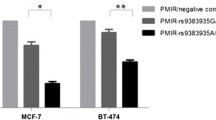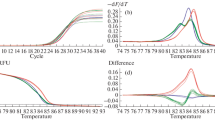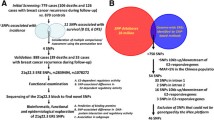Abstract
Background
Tamoxifen can reduce the occurrence of breast cancer by a half in high-risk women. Recently, a genome-wide association study identified two single-nucleotide polymorphisms (SNPs) near or in the CTSO and ZNF423 genes that were associated with breast cancer risk during tamoxifen therapy. We hypothesized that these two SNPs could be associated with increased recurrence in breast cancer patients who received adjuvant tamoxifen therapy.
Methods
A total of 586 breast carcinomas were available for SNP genotyping assays. TaqMan pre-designed SNP genotyping assays were used to identify the presence of CTSO rs10030044 and ZNF423 rs8060157. We then investigated the relationship between CTSO rs10030044 genotypes and mRNA expression levels of CTSO and BRCA1 in 290 breast cancer patients.
Results
We found a positive correlation between the variant GG genotype of CTSO rs10030044 and shorter disease-free survival, or overall survival in hormone receptor-positive breast cancer patients receiving adjuvant tamoxifen therapy. In contrast, this genotype was not associated with prognosis in hormone receptor-negative breast cancer patients. Multivariate Cox regression analysis revealed that this genotype was an independent factor indicating a poor prognosis in hormone receptor-positive breast cancer patients receiving adjuvant tamoxifen therapy. No association was found between CTSO genotype and mRNA expression of CTSO and BRCA1. ZNF423 rs8060157 genotype was not associated with prognosis in this study.
Conclusion
We show that a SNP near the CTSO gene is a poor prognostic factor in breast cancer although further research might help to reveal the factors linking this genotype and prognosis.


Similar content being viewed by others
References
Harvey JM, Clark GM, Osborne CK et al (1999) Estrogen receptor status by immunohistochemistry is superior to the ligand-binding assay for predicting response to adjuvant endocrine therapy in breast cancer. J Clin Oncol 17:1474–1481
Early Breast Cancer Trialists’ Collaborative Group (2005) Effects of chemotherapy and hormonal therapy for early breast cancer on recurrence and 15-year survival: an overview of the randomised trials. Lancet 365:1687–1717
Early Breast Cancer Trialists’ Collaborative Group (1998) Tamoxifen for early breast cancer: an overview of the randomised trials. Lancet 351:1451–1467
Davies C, Pan H, Godwin J et al (2013) Long-term effects of continuing adjuvant tamoxifen to 10 years versus stopping at 5 years after diagnosis of oestrogen receptor-positive breast cancer: ATLAS, a randomised trial. Lancet 381:805–816
Fisher B, Costantino JP, Wickerham DL et al (1998) Tamoxifen for prevention of breast cancer: report of the National Surgical Adjuvant Breast and Bowel Project P-1 Study. J Natl Cancer Inst 90:1371–1388
Vogel VG, Costantino JP, Wickerham DL et al (2006) Effects of tamoxifen vs raloxifene on the risk of developing invasive breast cancer and other disease outcomes: the NSABP Study of Tamoxifen and Raloxifene (STAR) P-2 trial. JAMA 295:2727–2741
Vogel VG, Costantino JP, Wickerham DL et al (2010) Update of the National Surgical Adjuvant Breast and Bowel Project Study of Tamoxifen and Raloxifene (STAR) P-2 Trial: preventing breast cancer. Cancer Prev Res (Phila) 3:696–706
Ingle JN, Liu M, Wickerham DL et al (2013) Selective estrogen receptor modulators and pharmacogenomic variation in ZNF423 regulation of BRCA1 expression: individualized breast cancer prevention. Cancer Discov 3:812–825
Velasco G, Ferrando AA, Puente XS et al (1994) Human cathepsin O. molecular cloning from a breast carcinoma, production of the active enzyme in Escherichia coli, and expression analysis in human tissues. J Biol Chem 269:27136–27142
Santamaria I, Pendas AM, Velasco G et al (1998) Genomic structure and chromosomal localization of the human cathepsin O gene (CTSO). Genomics 53:231–234
Tariq M, Belmont JW, Lalani S et al (2011) SHROOM3 is a novel candidate for heterotaxy identified by whole exome sequencing. Genome Biol 12:R91
Turner J, Crossley M (1999) Mammalian Kruppel-like transcription factors: more than just a pretty finger. Trends Biochem Sci 24:236–240
Huang S, Laoukili J, Epping MT et al (2009) ZNF423 is critically required for retinoic acid-induced differentiation and is a marker of neuroblastoma outcome. Cancer Cell 15:328–340
Elston CW, Ellis IO (1991) Pathological prognostic factors in breast cancer. I. The value of histological grade in breast cancer: experience from a large study with long-term follow-up. Histopathology 19:403–410
Marks JR, Huper G, Vaughn JP et al (1997) BRCA1 expression is not directly responsive to estrogen. Oncogene 14:115–121
Fan S, Wang J, Yuan R et al (1999) BRCA1 inhibition of estrogen receptor signaling in transfected cells. Science 284:1354–1356
Nakamura S, Takahashi M, Tozaki M et al (2013) Prevalence and differentiation of hereditary breast and ovarian cancers in Japan. Breast Cancer 22(5):462–468
Paik S, Tang G, Shak S et al (2006) Gene expression and benefit of chemotherapy in women with node-negative, estrogen receptor-positive breast cancer. J Clin Oncol 24:3726–3734
Acknowledgments
This work was, in part, supported by JSPS KAKENHI Grant Number 15K10061.
Author information
Authors and Affiliations
Corresponding author
Ethics declarations
Conflict of interest
Yukari Hato, Naoto Kondo, Nobuyasu Yoshimoto, Yumi Endo, Tomoko Asano, Yu Dong, Mayumi Nishimoto, Satoru Takahashi, Yoshitaka Fujii, Ryoichi Nakanishi have no conflict of interest. Tatsuya Toyama received a research grant from Takeda Pharmaceutical Co., Ltd., Daiichi Sankyo Healthcare Co., Ltd. and Novartis Pharma K.K.
Electronic supplementary material
Below is the link to the electronic supplementary material.
10147_2015_913_MOESM1_ESM.pptx
Supplementary material 1 (PPTX 59 kb). Supplemental Fig. 2 Kaplan–Meier survival curves of breast cancer patients categorized by the three genotypes (TT, GT, and GG) of CTSO rs10030044. Graphs show disease-free survival (DFS) (G) and overall survival (OS) (H) for hormone receptor-positive breast cancer patients receiving adjuvant tamoxifen therapy
About this article
Cite this article
Hato, Y., Kondo, N., Yoshimoto, N. et al. Prognostic impact of a single-nucleotide polymorphism near the CTSO gene in hormone receptor-positive breast cancer patients. Int J Clin Oncol 21, 539–547 (2016). https://doi.org/10.1007/s10147-015-0913-5
Received:
Accepted:
Published:
Issue Date:
DOI: https://doi.org/10.1007/s10147-015-0913-5




